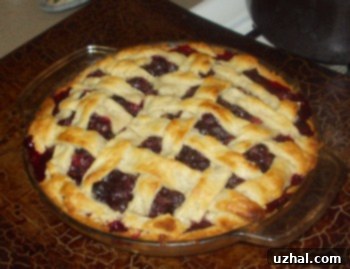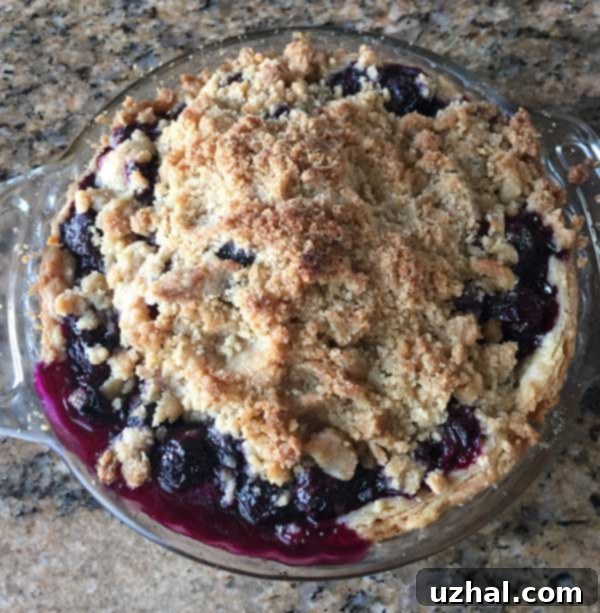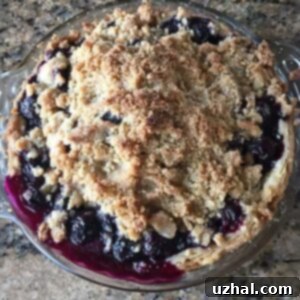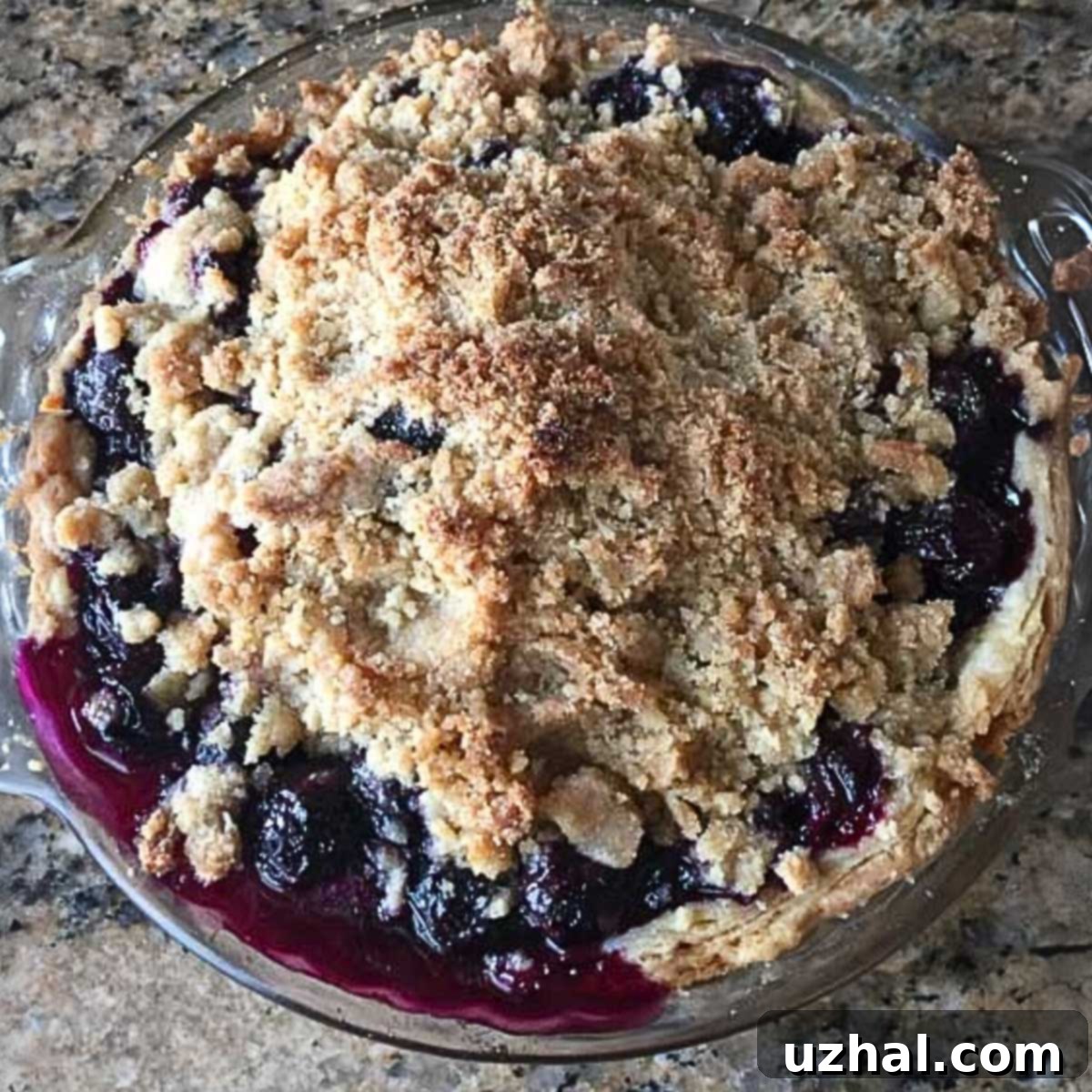The Ultimate Homemade Blueberry Pie Recipe: Classic Lattice or Irresistible Crumb Topping (Using Tapioca or Flour Thickener)
There’s something truly magical about a homemade blueberry pie. The burst of sweet-tart blueberries, encased in a flaky crust, evokes feelings of warmth, comfort, and pure delight. This particular blueberry pie recipe has been a long-standing favorite in my kitchen, perfected over years to ensure a consistently delicious result. What makes it truly special is its incredible flexibility, allowing you to tailor key elements to your preference or what you have on hand.
From the outset, this recipe embraced the traditional method of thickening the luscious blueberry filling with ground instant tapioca, derived from tapioca pearls. For those who enjoy a bit of an old-school touch and are willing to grind the pearls themselves, this method remains an excellent choice, yielding a clear, glossy filling that lets the natural color of the blueberries shine. However, the world of baking evolves! Thanks to the increasing popularity of gluten-free alternatives, tapioca flour (also known as tapioca starch) has become significantly more accessible in mainstream grocery stores. It’s a fantastic, easy-to-use substitute that performs just as beautifully, offering the same desirable clear finish to your pie filling.

Mastering Your Thickener: Tapioca, Flour, or Arrowroot?
While tapioca options are fantastic, convenience often wins. These days, I frequently find myself reaching for the most common kitchen staple: original ⅓ cup of all-purpose flour as the thickener. It’s especially handy when my supply of ground tapioca is low. Flour creates a perfectly set filling, though it might appear slightly more opaque than a tapioca-thickened one. The beauty of this recipe lies in its adaptability, allowing you to choose the thickener that best suits your pantry and preference.
If you’re committed to using tapioca, finding tapioca flour is easier than ever. Most well-stocked grocery stores now carry it, often in the baking or gluten-free aisle. This fine powder blends seamlessly into the fruit, ensuring a smooth, well-set filling. Another excellent alternative you might consider is arrowroot powder. Similar to tapioca flour, arrowroot yields a clear, stable filling, and it’s also a great gluten-free option. While I haven’t personally tested exact substitution ratios for arrowroot within *this* specific recipe yet, Spruce Eatsoffers some helpful guidelines on how much to use when experimenting with various fruit pies. Don’t be afraid to try it out!
Let’s dive deeper into each thickener to help you make an informed choice for your perfect pie.
Choosing the Right Thickener for Your Blueberry Pie
The secret to a perfect fruit pie often lies in its filling consistency. Too runny, and your pie collapses; too thick, and it loses its juicy appeal. Each thickener has unique properties that affect the final texture and appearance of your blueberry pie. Understanding these can elevate your baking game.
Ground Instant Tapioca (Tapioca Pearls)
Historically, ground instant tapioca pearls were a popular choice for fruit pies. When ground, these pearls dissolve and thicken during baking, creating a filling that is incredibly clear and shiny, allowing the vibrant color of the blueberries to truly stand out. It also produces a slightly “gel-like” texture that holds its shape beautifully when sliced. The main drawback these days is its availability – you might need to seek it out in specialty stores or grind it yourself from whole tapioca pearls, which requires a coffee grinder or a strong food processor. Despite the effort, many purists swear by its superior results.
Tapioca Flour (Tapioca Starch)
With the rise of gluten-free baking, tapioca flour has become a modern kitchen hero. It’s essentially the same as tapioca starch, and it’s much finer than ground tapioca pearls, making it incredibly easy to incorporate into your filling without any grinding. Like its pearl counterpart, tapioca flour creates a wonderfully clear and glossy filling that sets beautifully. It’s an excellent choice for those looking for a gluten-free option or simply a fuss-free way to achieve a perfect, non-cloudy blueberry filling. If using tapioca flour instead of ground instant tapioca, you may need a slightly lesser amount (e.g., 3 tablespoons instead of ¼ cup, but always refer to the specific recipe guidance).
All-Purpose Flour
The workhorse of many kitchens, all-purpose flour is arguably the most common and convenient thickener. Almost everyone has it on hand, making it a reliable default. Flour-thickened fillings tend to be a bit more opaque than those made with tapioca or arrowroot, giving the filling a softer, creamier consistency. While it doesn’t offer the same “shine,” it reliably sets the pie. The key with flour is to ensure it cooks thoroughly to avoid any raw flour taste. The ⅓ cup specified in this recipe is a tried-and-true amount that works wonderfully for a firm, yet tender, blueberry filling.
Arrowroot Powder
Arrowroot powder is another fantastic natural thickener, often used as a direct substitute for cornstarch or tapioca flour. It yields a clear, glossy filling similar to tapioca and is also gluten-free. Arrowroot is particularly good for delicate sauces and fillings because it thickens at a lower temperature and produces a very smooth texture. However, it can break down if overcooked or exposed to high acidity for too long, so it’s best to add it towards the end of cooking if possible, or ensure baking times are not excessively long. If you’re experimenting with arrowroot in this recipe, follow the general rule of thumb for tapioca flour substitutions, possibly starting with slightly less and adjusting as needed.

Crust or Crumb Topping: Customizing Your Blueberry Pie Experience
Beyond the filling, another delightful customization point for this blueberry pie is the topping. While the recipe card provides instructions for a beautiful, classic lattice crust, I often find myself gravitating towards a comforting crumb topping. This simple swap adds an incredible layer of buttery, sweet texture and allows the vibrant blueberry filling to truly be the star of the show. You can see what the crumb topping looks like in the image above; the full directions for this delicious variation are conveniently located in the notes section of the recipe card.
The Elegance of a Lattice Top
A traditional lattice crust is a work of art. It not only provides a lovely visual appeal but also allows steam to escape during baking, preventing a soggy crust and ensuring the filling bubbles up beautifully. Crafting a lattice top demonstrates a certain level of baking skill and adds an undeniable touch of rustic elegance to your pie. The strips of golden crust interweaving over the dark blueberries are truly picturesque and a joy to present at any gathering.
The Comfort of a Crumb Topping
For those who prefer a less fussy approach or simply adore the buttery, streusel-like texture, a crumb topping is an absolute dream. It’s quicker to prepare than a second crust and adds a delightful crunch that contrasts wonderfully with the soft, juicy blueberry filling. My personal preference leans towards this option for its ease and the extra layer of flavor and texture it brings. It’s a fantastic choice for a more casual, rustic pie that still delivers on taste and visual appeal.
Crafting the Perfect Pie Crust: Essential Tips for Success
A great pie starts with an exceptional crust. Even the most delicious blueberry filling can’t save a sub-par crust. Here are some indispensable tips to ensure your pie crust is flaky, tender, and perfectly golden every time.
Keep Ingredients Cold
This is perhaps the most crucial rule for a flaky pie crust. Ensure your butter and shortening are very cold, ideally straight from the refrigerator, or even frozen and grated. The cold fat creates pockets of steam during baking, which separate the layers of dough, resulting in that desirable flaky texture. If your fats get too warm, they’ll melt into the flour, leading to a tough, cookie-like crust.
Don’t Overwork the Dough
Mix the dough just until it comes together. Overworking develops the gluten in the flour, making the crust tough. You want to see small bits of fat still visible in the dough, as these will contribute to flakiness. The goal is to hydrate the flour just enough for the dough to form a ball, not to knead it like bread.
Use Just Enough Water
Add cold water gradually, a tablespoon at a time, until the dough just barely holds together when squeezed. The exact amount can vary based on flour and humidity. Too much water makes the dough sticky and tough; too little makes it crumbly and hard to roll. Aim for a dough that is cohesive but not wet.
Chill Your Dough
Chilling the dough for at least 30 minutes (or longer) before rolling helps relax the gluten, making it easier to roll out. It also firms up the fats, which again contributes to flakiness. If your dough becomes sticky or difficult to work with during rolling, a quick 10-15 minute return to the freezer can work wonders, as mentioned in the recipe instructions.
Blind Bake for a Crispy Bottom
Especially for juicy fruit pies like blueberry, blind baking the bottom crust is essential to prevent a soggy bottom. This pre-baking step creates a barrier, ensuring the crust is partially cooked and firm before the wet filling is added. Use pie weights or dried beans to keep the crust from puffing up. This step is clearly outlined in the recipe and is key to a perfectly baked pie.
Selecting and Preparing Your Blueberries for the Best Flavor
The quality of your blueberries directly impacts the taste of your pie. Choosing the right berries and preparing them properly ensures a delightful filling.
Fresh vs. Frozen Blueberries
Fresh Blueberries: When in season, fresh blueberries are unbeatable for their vibrant flavor and aroma. Look for plump, firm berries with a dusty bloom, indicating freshness. Gently wash them just before use and pat them dry. This recipe is written with fresh blueberries in mind.
Frozen Blueberries: Don’t let the season dictate your pie cravings! Frozen blueberries are a perfectly acceptable substitute and are often picked at their peak ripeness. There’s no need to thaw them before adding them to the filling; simply toss them with the lemon juice, thickener, and sugar while still frozen. Be aware that frozen berries may release more liquid, so you might consider adding an extra teaspoon of your chosen thickener to ensure the filling sets perfectly.
Baking Your Blueberry Pie: Signs of Perfection
Knowing when your pie is perfectly baked is crucial for both flavor and texture. Look for these signs:
- Golden Crust: The crust should be deeply golden brown, indicating it’s fully cooked and crispy.
- Bubbly Filling: For a fruit pie, the filling should be visibly bubbling in the center, not just at the edges. This signifies that the thickener has activated and the fruit juices are hot enough to set properly.
- Aroma: Your kitchen will be filled with an intoxicating sweet blueberry aroma, a sure sign that deliciousness is nearing completion.
Once baked, resist the urge to slice into your pie immediately! It’s vital to let fruit pies cool completely, typically for several hours, to allow the filling to set properly. This prevents a runny mess and ensures clean, beautiful slices.
Serving Suggestions for Your Delicious Homemade Pie
While a slice of this blueberry pie is heavenly on its own, a few additions can elevate the experience even further:
- A la Mode: A scoop of good quality vanilla bean ice cream is a classic pairing, the cold creaminess a perfect contrast to the warm fruit.
- Whipped Cream: A generous dollop of freshly whipped cream adds a light, airy sweetness.
- A Dusting of Sugar: For a simple finish, a light dusting of powdered sugar adds a touch of elegance.
- Tapioca Flour Brownies
- Cookie Madness Best Cookies of 2022
- Coconut Milk Chocolate Ice Cream
- Minute Tapioca Cherry Pie
- Gluten-Free Raisin Bread
Recipe: Classic Blueberry Pie

Blueberry Pie
Anna
Pin Recipe
Ingredients
Crust:
- 2 ½ cups all purpose flour (315 grams)
- 1 teaspoon salt
- 2 tablespoons sugar (25 grams)
- Pinch cinnamon optional
- 12 tablespoons shortening, cut into chunks (144 grams)
- 6 tablespoons butter, grated or just cut up (84 grams)
- ⅓-1/2 cup cold water
Filling:
- 4 cups fresh blueberries see note
- 1 tablespoon fresh lemon juice
- ¼ cup tapioca ground up in coffee grinder (or ⅓ cup flour)
- ½ teaspoon cinnamon
- ¾ cup sugar
Instructions
-
Combine flour, sugar, salt and cinnamon in a large bowl or in the bowl of the food processor. Using a pastry cutter or your fingers (or the processor, if using), cut the shortening and butter into the flour mixture until crumbly. Add water a few tablespoons at a time, stirring until dough holds together. Shape into one big ball, then divide in half and make two spheres. Place each sphere in a zipper bag.
-
When ready to make pie, proceed as follows. Place berries in a large mixing bowl and toss with lemon juice. Combine ground tapioca, cinnamon and sugar. Pour over berries and stir to coat berries. Let sit for about 15 minutes.
-
Meanwhile, remove one sphere of pie dough from refrigerator but keep it in the zipper bag. Roll dough out in zipper bag. Cut side of zipper bag. Invert dough circle over 9 inch glass pie plate and carefully peel away zipper bag. If dough seems too sticky to work with, throw it in the freezer for a few minutes. Poke holes all over dough with a fork, press a piece of foil gently over the pie dough shell, weigh down with pie weights and bake on a rimmed baking sheet at 400 degrees F. for 10 minutes.
-
While the pie shell bakes, take out second half of dough and roll into a big circle. Cut into ¾ inch strips.
-
Put the blueberry mixture into the baked pie shell, arrange the strips in a lattice pattern over the blueberries, set on a rimmed baking sheet and bake at 400 for 35 minutes.
Notes
Skip the second crust and forget the lattice.
Bake the bottom crust as directed for 10 minutes, covered with foil and weighed down with pie weights.
Mix together the ingredients below and sprinkle over the filling, then bake on a rimmed baking sheet at 375 F (rather than 400F) for about 45 minutes. After about 30 minutes, lay a sheet of foil over the topping to prevent it from over-browning.
Crumb Topping:
½ cup plus 2 tablespoons all-purpose flour
3 tablespoons dark brown sugar, golden okay too
2 tablespoons granulated sugar
¼ teaspoon cinnamon
⅛ teaspoon salt (omit if using salted butter)
4 tablespoons unsalted butter, melted and cooled
¼ teaspoon vanilla extract (optional)
Why This Blueberry Pie Recipe Will Be Your Go-To
This blueberry pie recipe isn’t just about ingredients and instructions; it’s about tradition, adaptability, and the pure joy of baking. Whether you choose the classic lattice top or the inviting crumb topping, or decide between the traditional ground tapioca or the more convenient all-purpose flour, you’re guaranteed a pie that’s bursting with flavor and love. It’s a recipe designed to be flexible, allowing you to create a dessert that perfectly fits your taste, your pantry, and your schedule.
From the first bite of its flaky crust to the last spoonful of its sweet, juicy filling, this blueberry pie promises to be a memorable experience. It’s perfect for summer gatherings, holiday tables, or simply a comforting treat on a quiet evening. We hope this comprehensive guide inspires you to bake a masterpiece that brings smiles to everyone around your table.
